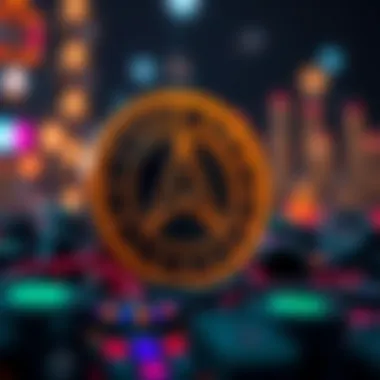Ankr's Role in Shaping the Future of Web 3.0


Intro
The dawn of Web 3.0 is upon us, a reality shaped profoundly by decentralized networks and user empowerment. Amid this transformative wave, Ankr stands out as a pivotal player, offering robust infrastructure tailored for the blockchain ecosystem. It's not just about building tech; it's about reshaping how we interact with the digital world. With Ankr, developers and users alike find the tools necessary for innovative solutions, paving the way for a decentralized web that could redefine internet interactions.
But what does this mean for the average investor or the astute analyst? With myriad possibilities opening, understanding the intricate details behind Ankr’s offerings becomes essential. This examination will illuminate the core aspects of Ankr’s infrastructure, emerging trends in the cryptocurrency market, and the vital role Ankr plays in steering the future of Web 3.0.
Understanding Cryptocurrency Concepts
Blockchain Technology Explained
At the heart of Ankr's offerings is blockchain technology, a system that secures and verifies transactions through a decentralized network of computers. Unlike traditional databases, which store data in centralized locations, blockchains distribute information across numerous nodes, enhancing security and trustworthiness. This technology is the backbone of not just Ankr, but the entire Web 3.0 landscape.
Blockchains work like a digital chain of blocks, where each block contains data relating to transactions, a timestamp, and a cryptographic link to the previous block. This structure creates an immutable ledger, providing transparency in all actions taken. In essence, every time a transaction occurs, it gets recorded in a block, and once confirmed, it becomes a permanent part of the blockchain. This mechanism fosters trust in an environment that often lacks centralized authority.
Key Terms Every Investor Should Know
Understanding the language of cryptocurrency is crucial for investors. Here are some key terms:
- Decentralization: The distribution of authority away from a central figure or entity, allowing users more control over their data and transactions.
- Smart Contracts: Self-executing contracts with the terms of the agreement directly written into code, allowing for automated transactions without intermediaries.
- DApps (Decentralized Applications): Applications that run on a blockchain network rather than being hosted on centralized servers.
- Nodes: Computers in a blockchain network that maintain the blockchain's integrity by validating transactions.
- Gas Fees: Costs required for executing transactions on the blockchain, typically paid in the blockchain's native cryptocurrency.
By familiarizing oneself with these concepts, investors can better navigate the evolving landscape of cryptocurrency and capitalize on the opportunities presented by platforms like Ankr.
Market Analysis and Trends
Current Market Trends in Cryptocurrency
The cryptocurrency market is ever-changing, influenced by technological advancements, regulatory news, and user adoption rates. As Web 3.0 inches closer to mainstream acceptance, the demand for decentralized platforms continues to rise.
Recently, many projects have focused on scalability solutions, ensuring that blockchain can handle a larger volume of transactions without compromising speed or efficiency. Ankr, with its emphasis on decentralized cloud services, is perfectly positioned to capitalize on these trends, providing developers with the resources needed to scale.
Investment Strategies for Different Market Conditions
Understanding how to approach cryptocurrency investment hinges on market conditions. Here are some strategies:
- Bull Market: In a rising market, investors often adopt a buy-and-hold strategy on promising projects like Ankr, betting that the market will continue to appreciate.
- Bear Market: During downturns, a more cautious approach may be warranted, with an emphasis on diversifying one's portfolio to mitigate risks.
- Market Correction: Utilizing a dollar-cost averaging strategy can help maintain a consistent investment practice, reducing the impact of volatility.
Investing is like baking: a dash of patience mixed with a pinch of strategy yields the best results.
As the Web 3.0 landscape develops, Ankr's role in decentralizing infrastructure and providing high-performing services could transform how investors think about their portfolios in this space. Through this detailed examination, we can aim for a clearer understanding of both Ankr's offerings and the overall momentum of our digital future.
For deeper insights and further exploration into Ankr and cryptocurrencies, check out resources like Wikipedia, Britannica, and relevant threads on Reddit.
Understanding Web 3.
The evolution of the internet has seen the transformation from static web pages to interactive platforms, and then to the emerging paradigm referred to as Web 3.0. This transition is not just a technical upgrade; it's a fundamental shift in how users interact with the digital world. In this section, we will explore what Web 3.0 entails, its significance, and its implications for the future of digital interactions.
The Evolution from Web 2. to Web 3.
Web 2.0 marked an era where user-generated content and social networking thrived. Platforms like Facebook and YouTube allowed users to share information, but this also came at a cost; user data was often monetized, and control resided with centralized corporations. As digital users became aware of these practices, the thirst for a more autonomous internet grew. This desire is giving birth to Web 3.0, where decentralization is at the helm.
In Web 3.0, the focus is no longer on data silos but instead on data ownership. Every individual is treated as a key participant, wielding control over their information and interactions. Innovations like blockchain technology have catalyzed this shift, enabling peer-to-peer transactions and services without the need for an intermediary.
Defining Characteristics of Web 3.
Web 3.0 boasts several defining characteristics that shape its framework:
- Decentralization: Unlike its predecessor, power is distributed away from central authorities, allowing users greater control.
- Interoperability: Platforms are designed to work seamlessly with one another, paving the way for a more cohesive user experience.
- Enhanced security: Blockchain protocols provide a level of security that traditional systems cannot, protecting user data from hacking.
- Smart contracts: These self-executing contracts allow for automated transactions without human intervention, simplifying processes immensely.
These features are not merely theoretical; they serve to make interactions more transparent and trustworthy.
Decentralization: The Core Principle
At the heart of Web 3.0 lies the principle of decentralization. This isn't just about the absence of central authority; it's about empowering users. In a decentralized web, users are no longer at the mercy of corporations that profit from their data. They become the owners of their digital footprint.
"With decentralization, we shift power dynamics, granting individuals autonomy previously unseen in the digital realm."


Decentralized applications (DApps) serve as manifestations of this principle by operating on peer-to-peer networks. They are designed to be permissionless, meaning that access is available to anyone, without gatekeeping. This has profound implications for innovation, enabling a broader range of voices and solutions in tech.
Ankr's Infrastructure Solutions
In the rapidly evolving ecosystem of Web 3.0, the role of infrastructure solutions can't be overstated. Ankr stands at the crossroads of innovation, offering robust services that not only simplify blockchain interactions but also empower developers and users alike. The increasing complexity of decentralized applications (DApps) demands reliable infrastructure. Ankr's offerings serve this need, ensuring that developers can build efficiently without getting bogged down by technical challenges. By championing decentralized infrastructure, Ankr aligns itself with the core ethos of Web 3.0, which is about putting control back into the hands of users.
Overview of Ankr's Platform
At the heart of Ankr's ecosystem lies its platform, designed to support a broad range of blockchain protocols and decentralized solutions. This versatile platform provides a seamless development environment. With support for multiple programming languages and frameworks, developers find themselves in a sweet spot where building solutions is not only feasible but also efficient. The platform's architecture supports high availability and scalability, two critical requirements for any application navigating the unpredictable currents of the blockchain space. Ankr's platform simplifies node deployment, enabling users to set up nodes across various chains effortlessly.
Node Hosting Services
Ankr's node hosting services represent a significant feature of its infrastructure strategy. Traditional node setups require considerable investment in hardware and maintenance, which can discourage many developers from fully engaging with blockchain technology. Ankr flips this script by offering reliable cloud networking that takes away the heavy lifting. Users can easily deploy nodes in real-time, which allows their applications to interact directly with various blockchains without needing their own hardware.
This service not only saves costs but also boosts performance, as nodes distributed over Ankr’s global network prevent bottlenecks that can arise from localized infrastructure.
- Benefits of Node Hosting with Ankr:
- Cost-effective: No need for expensive hardware investments.
- Scalable: Effortlessly manage increases in demand.
- Global Reach: Distributed nodes enhance application responsiveness across regions.
Blockchain Interoperability
One of the standout aspects of Ankr's offering is its focus on blockchain interoperability. In a world where different chains often operate in silos, Ankr breaks down these barriers. It allows applications to engage with multiple blockchains seamlessly, ensuring that users can harness the strengths of various ecosystems without being tied down to a single chain. This capability not only fosters innovation but also creates a more inclusive environment for DApp developers.
To summarize, Ankr’s infrastructure solutions are at the forefront of addressing key challenges posed in the emerging Web 3.0 landscape.
"The capacity for a decentralized infrastructure to support a myriad of blockchain applications is what will drive the future of Web 3.0."
As demands for reliable, efficient, and scalable tools grow, Ankr seems poised to play a significant role in shaping the next phase of the internet.
Ankr's Impact on Decentralized Applications
As the digital landscape shifts towards an ecosystem based on decentralization, Ankr emerges as a significant player in enabling decentralized applications (DApps) to thrive. The importance of Ankr in this context cannot be overstated; it effectively provides the necessary infrastructure and tools that simplify the development and deployment of DApps. Given the surge in interest surrounding blockchain technology, Ankr’s solutions hold the potential to not only support existing applications but also pave the way for novel, innovative projects that leverage the principles of Web 3.0.
Supporting Developers in a Web 3. Era
In today's digital age, developers face numerous hurdles when creating DApps. The transition from traditional applications to decentralized models requires a shift in mindset, technology, and infrastructure. Ankr steps in to bridge these gaps by offering a comprehensive suite of services designed with developers in mind.
- User-Friendly Interfaces: The platform offers intuitive interfaces that allow developers, regardless of their expertise, to easily navigate the intricacies of blockchain integration. This helps reduce the barrier to entry, allowing new projects to come to life without the steep learning curve typically associated with blockchain technology.
- Robust Infrastructure: Ankr provides the backbone that enables developers to host applications securely and efficiently. By leveraging a decentralized network of nodes, developers can ensure high availability and reliability, critical factors for the success of any application.
- Comprehensive Documentation: Clear guidelines and resources equip developers to harness the full power of Ankr's offerings, enabling smooth project initialization and progression.
By focusing on these aspects, Ankr fosters a vibrant community of developers and allows them to innovate freely within the Web 3.0 framework.
Facilitating DApp Growth and Adoption
For decentralized applications to reach their full potential, widespread adoption is essential. Ankr plays a fundamental role in this area by creating conducive environments for DApps to flourish. Here’s how Ankr facilitates DApp growth and adoption:
- Scalability Solutions: With blockchain technology sometimes facing issues related to scalability, Ankr meets this challenge head-on by ensuring high throughput and low latency on its platform. This level of performance is essential in retaining users, as delays can severely hamper user experience.
- Interoperability: As the blockchain ecosystem consists of multiple chains, interoperability is a key factor for DApp success. Ankr allows for seamless communication between different blockchains, enabling developers to create applications that tap into various ecosystems, which in turn increases their user base.
- Community Engagement: A thriving developer community fosters collaboration and feedback, essential for iterative improvement of DApps. Ankr actively nurtures this ecosystem by organizing events and initiatives that bridge developers and users.
Use Cases of Ankr in DApps
To truly appreciate Ankr's impact on decentralized applications, examining specific use cases demonstrates its versatility and effectiveness. Here are some notable examples:
- DeFi Applications: Through Ankr’s infrastructure, numerous decentralized finance applications benefit from enhanced performance and security. Projects operating in this space see faster transaction times and reduced costs, making them more attractive to users.
- Gaming Platforms: Ankr's ability to support high-demand gaming DApps is noteworthy. With features like rapid asset transfers and multiplayer interactions, it has become a preferred choice for game developers seeking to harness the power of blockchain for their projects.
- Data Storage Solutions: DApps requiring decentralized data storage utilize Ankr's services to ensure data integrity and security. By leveraging its network, developers build applications that can store and retrieve data without centralized control, improving privacy and user security.
"The future of DApps hinges on the tools we provide today. Ankr is committed to paving the way for innovation through infrastructure."
Economic Models within Ankr
In the context of Ankr, economic models are not merely academic theories; they are the backbone of how its entire ecosystem operates. Understanding these models is crucial as they illustrate the incentives, mechanisms, and structures that drive participation within the network. The essence here lies in how the tokenomics—the economic aspects of token usage and distribution—can enhance user engagement and facilitate sustainable growth. Properly structured economic models ensure that every participant is fairly compensated for their contributions while also incentivizing long-term commitment to the platform.
Tokenomics of Ankr
Tokenomics for Ankr revolves around the use of its native token, ANKR, which serves multiple purposes within its ecosystem. This token is central to rewarding users and maintaining the integrity of transactions. Investors should note a few key features of Ankr's tokenomics:
- Utility: The ANKR token can be used to pay for services on the Ankr platform, such as node hosting and infrastructure services. This ensures a direct relationship between the token's value and the utility it provides.
- Supply Dynamics: The total supply of ANKR tokens has been capped, which can lead to scarcity and potential appreciation in value as demand increases.
- Governance Rights: ANKR token holders are granted voting rights on significant protocol decisions, thus fostering a sense of community and involvement among users.
These pillars of tokenomics not only establish a robust operational framework but also build a compelling case for potential investors.


Staking Mechanisms and Rewards
Staking is a pivotal component in Ankr’s economic model, acting as a bridge between users and the network. Individuals can lock up their ANKR tokens to support network operations, contributing not only to security but also enhancing overall network performance. Here’s how it usually unfolds:
- Earning Rewards: Participants who stake their tokens are rewarded with more ANKR tokens. This incentivizes users to keep their tokens within the ecosystem instead of cashing out, which can benefit the platform’s stability.
- Collaboration with Validators: Stakers can collaborate with validators, contributing to transaction confirmations and earning a share of the transaction fees.
- Tiers of Staking: Ankr may introduce various staking tiers with different reward levels, encouraging users to lock up more tokens for greater benefits.
The staking process thus creates an environment where inactive tokens are mobilized, driving further utility and value accrual.
Incentives for Network Participation
Engagement in Ankr's ecosystem is not just about holding tokens; it’s about active participation in an evolving network. The incentives designed for network participation can be summarized as follows:
- Validation Rewards: Participants who operate nodes or act as validators receive transaction fees, providing a direct economic benefit and a compelling reason to become part of the network.
- Referral Programs: By tapping into social networks and communities, users can benefit from referring new participants, thus encouraging a growth-oriented community.
- Community Contributions: Ankr often rewards community suggestions or development efforts, making the ecosystem more collaborative and inclusive.
These incentives not only stimulate engagement but also ensure a continuous influx of new ideas and users, which are critical for sustaining the network's long-term growth.
With a robust economic model, Ankr empowers its users to actively shape the decentralized ecosystem, enhancing both participation and investment potential.
The evolving economic models within Ankr illustrate its commitment to fostering an environment where every participant can thrive. In summary, Ankr has crafted a thoughtful framework that strategically ties together tokenomics, staking rewards, and incentives for participation—elements that will be vital as Web 3.0 continues to unfold, creating a digital landscape filled with opportunities and potential.
Strategic Partnerships and Collaborations
Strategic partnerships and collaborations play a pivotal role in the advancement of any technology, and Ankr is no exception. In the broad context of Web 3.0, where decentralization reigns supreme, the synergy drawn from partnerships becomes a crucial factor for driving innovation and scaling solutions. These alliances not only boost Ankr's capabilities but also enhance its overall ecosystem. They position Ankr as a leader in the blockchain space, tapping into diverse resources, insights, and technological frameworks that would be challenging to build independently.
Notable Partnerships in the Blockchain Space
Ankr has carved its niche by fostering partnerships that resonate with its mission of decentralization. One of its prominent collaborations is with Binance Smart Chain, which opens doors for developers to build on a robust infrastructure while leveraging Binance's extensive global reach. Furthermore, Ankr has partnered with Chainlink, enhancing the security and functionality of decentralized applications by providing reliable oracles. Partnerships with other blockchain networks, such as Ethereum and Polkadot, emphasize a commitment to interoperability—bridging various chains and enabling seamless communication between them. These collaborations not only enrich the Ankr platform but also empower developers to create more versatile applications.
"In the interconnected world of blockchain, partnerships are the threads that weave a stronger fabric of collaboration and innovation."
The Role of Collaborations in Scalability and Growth
Collaborations significantly contribute to Ankr's scalability and growth, both from a technological and a community perspective. By aligning with other key players in the blockchain ecosystem, Ankr can share the load—and the rewards—of developing new capabilities. When one network benefits, others often follow suit; this symbiotic relationship in the blockchain realm leads to enhanced user experience without compromising decentralization principles. This approach allows Ankr to continuously evolve, addressing ever-changing market needs and technological advancements.
As Ankr continues to grow, its relationships with various stakeholders foster a vibrant community where ideas flow freely, and innovation thrives. The collective expertise and resources of these partnerships enable rapid responses to challenges, ensuring that Ankr remains at the forefront of Web 3.0 infrastructure providers. Thus, an understanding of the strategic partnerships and collaborations is not just beneficial; it's essential for grasping Ankr's potential impact in shaping a decentralized future.
In summation, Ankr’s strategic partnerships facilitate significant operational advantages, allowing it to innovate and scale in a competitive landscape. By leveraging the power of collaboration, Ankr can enhance its offerings, drive user adoption, and ultimately transform the Web 3.0 ecosystem into a more decentralized, interconnected entity.
Challenges Facing Ankr and the Web 3. Landscape
Understanding the challenges faced by Ankr in the context of Web 3.0 is fundamental to grasping its overall strategy and future trajectory. As the decentralized landscape rapidly evolves, various hurdles emerge that not only threaten Ankr's operations but also impact the adoption and realization of Web 3.0’s potential. Examining these challenges highlights crucial aspects such as technical limitations, regulatory pressures, and competitive dynamics, which, if addressed, could pave the way for innovative solutions and a more robust ecosystem for all stakeholders.
Technical Challenges and Limitations
Ankr's ambition to provide a seamless decentralized infrastructure faces a plethora of technical hurdles. These issues range from performance benchmarks to scalability that could potentially undermine its services.
One significant technical challenge includes network latency. As Ankr hosts various nodes across different geographic locations, the efficiency of interaction between these nodes can significantly vary. If delays in data transmission occur, users may experience a lag in application performance, which could deter developers from using Ankr’s services.
Moreover, the interoperability between different blockchain networks is another thorny issue. Without seamless communication among various systems, the potential for decentralized applications (dApps) becomes limited. If Ankr’s platform doesn’t facilitate smooth cross-chain interactions, it could lead to fragmented solutions that miss the holistic vision of Web 3.0.
"Technical difficulties are like uninvited guests at a party, often making an appearance when least expected. For Ankr, addressing these challenges means ensuring that the party goes on smoothly and merrily."
Additionally, Ankr must consider security vulnerabilities inherent in decentralized platforms. Data breaches, hacks, and inadequate protocols can severely compromise trust, potentially jeopardizing user engagement and loyalty. This brings forth the necessity for robust security frameworks and protocols that not only protect users but also enhance the overall resilience of the infrastructure.
Regulatory Considerations
As Ankr strides further into the Web 3.0 landscape, navigating the regulatory framework becomes paramount. The world of blockchain and cryptocurrencies remains under scrutiny by government bodies worldwide. This regulatory uncertainty can pose challenges on multiple fronts for Ankr.
Firstly, various jurisdictions have different approaches to blockchain regulations. Some embrace cryptocurrencies, while others impose stringent laws. Ankr has to ensure compliance with these regulations, which may differ starkly from one region to another. This makes it quite challenging to develop a universal strategy that caters to all markets, especially when it comes to user data protection and financial transactions.
Secondly, the evolving nature of taxation policies on cryptocurrencies can also create issues. As tax frameworks are implemented, Ankr must adjust its processes to accommodate changes that may arise. Failure to comply could result in hefty fines or even more severe repercussions.
Moreover, users’ trust can waver if they feel that data privacy and compliance are compromised. A lack of clarity in regulations could inhibit widespread user adoption, making it critical for Ankr to stay ahead of the legislative curve.
In summation, the challenges facing Ankr in the Web 3.0 landscape are varied and complex. From overcoming technical limitations to understanding the regulatory tapestry that governs the decentralized world, these hurdles are not merely operational but strategic in shaping the organization’s future. By addressing these challenges effectively, Ankr not only positions itself for success but also aids in fostering a resilient and compliant Web 3.0 ecosystem.


Future Prospects of Ankr in Web 3.
The future prospects of Ankr in the evolving landscape of Web 3.0 are not just a point of interest but a crucial pivot for many stakeholders in the blockchain ecosystem. As the demand for decentralized applications escalates, understanding Ankr’s role and capabilities becomes imperative. A myriad of benefits surface when examining the potential trajectory of Ankr’s offerings. Primarily, the combination of existing infrastructure with innovative advancements positions Ankr as a significant player in facilitating the transition to a decentralized web.
The implications of Ankr's future developments extend beyond mere technology; they signal a holistic approach to reimagining the internet itself. A more interconnected and user-driven platform could become a reality, powered by Ankr's solutions. Stakeholders, from developers to end-users, need to consider how Ankr's strategies will shape their experiences and expectations moving forward.
Trends Shaping the Future of Ankr's Offerings
Several trends currently reshape the environment in which Ankr operates. The growth of decentralized finance (DeFi) continues to gain momentum, with more platforms seeking reliable infrastructure to launch their services. This trend is highly relevant for Ankr. The emphasis on user privacy and data security grows stronger, which aligns seamlessly with Ankr’s decentralized architecture. As organizations look for ways to safeguard user data, Ankr's offerings come into focus.
Another notable trend is the increasing interest in green technologies. In an age where ecological impact is scrutinized, Ankr has the potential to harness eco-friendly blockchain solutions, which could provide a competitive edge.
- Increased adoption of smart contracts
- Rise of non-fungible tokens (NFTs)
- Demand for cross-chain compatibility
These elements point towards a future where Ankr’s initiatives will play an essential role in shaping the digital landscape, making it more accessible and efficient.
Projected Growth of Web 3. Technologies
The anticipated expansion of Web 3.0 technologies paints a promising picture for Ankr and similar platforms. Various analyses indicate significant growth prospects in the next several years. For instance, as institutional interest in blockchain technology increases, platforms that support scalable and decentralized solutions will likely see increased utilization.
Moreover, as emerging markets adopt crypto and blockchain technologies, Ankr stands poised to capitalize. In particular, the increasing integration of blockchain with other technologies like artificial intelligence and the Internet of Things enhances Ankr's relevance in multi-faceted applications.
"With the Web 3.0 evolution, companies like Ankr will not only contribute but also lead the charge in defining how we interact with the internet and each other."
To summarize, the future looks encouraging for Ankr within the Web 3.0 paradigm. Its infrastructure solutions will remain vital as they evolve with emerging trends, setting the stage for innovative applications and maintaining user-centric ecosystems. Investors and developers alike should pay close attention to how Ankr adapts to these trends, for the potential for growth and impact is undoubtedly on the horizon.
Comparative Analysis with Other Infrastructure Providers
In the rapidly evolving domain of Web 3.0, understanding where Ankr stands in relation to its competitors is not just useful—it's essential for investors, developers, and any stakeholder looking to navigate this emerging landscape. A comparative analysis offers insights into the approaching game of blockchain infrastructure, showcasing what Ankr does well and where it finds itself facing challenges. Evaluating Ankr alongside other providers illuminates critical aspects like reliability, cost, and technological advancements, which are key for any project in this nascent environment.
Strengths and Weaknesses of Ankr
When looking at Ankr's strengths, several factors come to the forefront. The platform specializes in providing a decentralized cloud computing service that prioritizes accessibility and low latency. Unique features, like its multi-chain support, mean that developers can easily integrate various blockchains into their DApps without a hitch. The use of a decentralized approach also enhances security, making it more resistant to potential attacks than traditional centralized services.
However, no solution is without its downsides. One significant weakness of Ankr might be its relative nascence when compared to more established players such as AWS or Google Cloud. Companies with more robust ecosystems may pose a challenge to Ankr’s foothold, especially in terms of branding and wide recognition. Additionally, as the network expands, scaling may lead to performance issues that can thwart user experience if not addressed timely.
Market Positioning Against Competitors
Positioning in the marketplace is crucial as well. Ankr is carving its niche by focusing solely on decentralized applications and the Web 3.0 stack, which sets it apart from giants like Microsoft Azure or IBM Cloud that are still rooted in more traditional cloud services. While these larger platforms offer extensive customizable solutions, they lack the specific focus on blockchain technologies that Ankr provides. This specialization allows Ankr to develop tailored solutions that can cater to unique user needs in a decentralized manner.
Additionally, when comparing pricing models, Ankr appears appealing to newcomers and small-to-medium enterprises looking to dip their toes into the blockchain waters. Its pay-as-you-go structure is not only cost-effective but comes with flexible options, making it an attractive choice for many developers. Conversely, traditional providers like Amazon Web Services may present overly complicated pricing that can easily generate unexpected bills, leading to disillusionment among users.
In summary, a comparative analysis of Ankr against other infrastructure providers unveils both its potential advantages and hurdles. As we observe the landscape, it becomes clear that ongoing innovation, coupled with a customer-first approach, will dictate how Ankr enhances its position and attracts users in an increasingly competitive arena.
“In the world of blockchain, who you choose as a partner can be as critical as the technology itself.”
Further Reading:
- Wikipedia on Web 3.0
- Britannica on Blockchain Technology
- Reddit discussions on Ankr
- Ankr official website
The Role of Community in Ankr's Ecosystem
In the fast-developing world of Web 3.0, community engagement plays a crucial role in pushing projects to greater heights and fostering innovation. Ankr, as a leading decentralized infrastructure provider, relies heavily on its community for support, evolution, and advocacy. The very essence of Ankr's approach resonates with the belief that when users are engaged, empowered, and informed, the entire ecosystem thrives.
The community around Ankr is more than just a user base; it represents a collaborative network of developers, contributors, and advocates who are actively participating in shaping the platform's future. This interconnected web of individuals harnesses collective wisdom, experiences, and resources to overcome challenges and bring ideas to fruition.
Building Engaged User Communities
Creating an engaged user community isn't just about gathering numbers. It's about building relationships, creating value, and facilitating collaboration. Ankr promotes several strategies that underpin its community-building efforts:
- Transparent Communication: Frequent updates, open discussions, and clarity in decisions encourage trust. Ankr’s dedication to transparency fosters a culture where users feel valued and heard.
- Educational Initiatives: Workshops, webinars, and comprehensive documentation equip users with the necessary tools to navigate the complexities of Web 3.0. This empowers them to utilize Ankr’s services effectively.
- Incentivization Programs: Rewarding community participation through token distributions or recognition programs amplifies engagement. When users know their contributions can lead to tangible benefits, they are more likely to invest time and effort into the community.
Such efforts create an environment where users not only consume resources but actively contribute to the ecosystem’s growth and vitality. This dynamic interaction can lead to innovative solutions that benefit all parties involved, reinforcing Ankr’s position within the decentralized web framework.
Feedback and Contributions from Users
User feedback is an invaluable resource that fuels continuous improvement. Ankr encourages its users to share insights, criticisms, and suggestions. This open channel does a few critical things for the platform:
- Improved Product Development: By actively soliciting feedback, Ankr is able to align its future enhancements with user needs, ensuring that its offerings remain relevant and effective.
- Strengthened Community Bonds: When users see their feedback accepted and implemented, it strengthens their connection to the project. They feel that their voices are substantive parts of the larger narrative.
- Crowdsourced Solutions: The wide-ranging expertise among community members means that solutions to problems can emerge organically, often quicker than a traditional corporate structure would allow.
Ankr's community feedback mechanisms underscore its commitment to user-centric development. Users who contribute not only enhance the ecosystem but also enjoy the satisfaction of having a stake in Ankr’s evolution.
"Community-driven projects can swiftly adapt to the nuances of user needs, leading to a vibrant ecosystem that evolves with its audience."
Overall, the community's role in Ankr's ecosystem cannot be understated. Their contributions, ideas, and feedback create a synergistic atmosphere that propels advancements within the Web 3.0 landscape, emphasizes inclusivity, and strengthens the fabric of Ankr’s operational principles.















